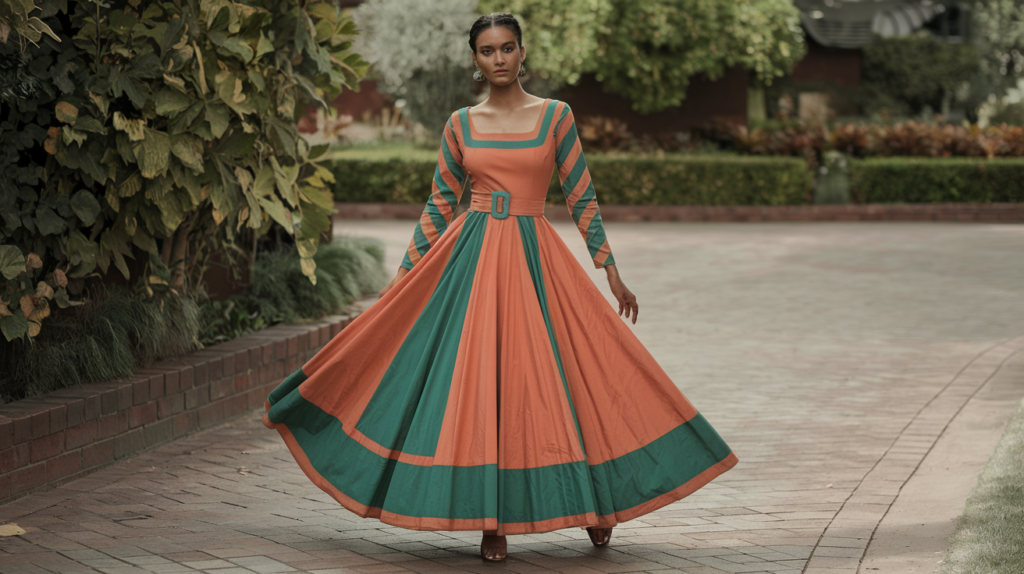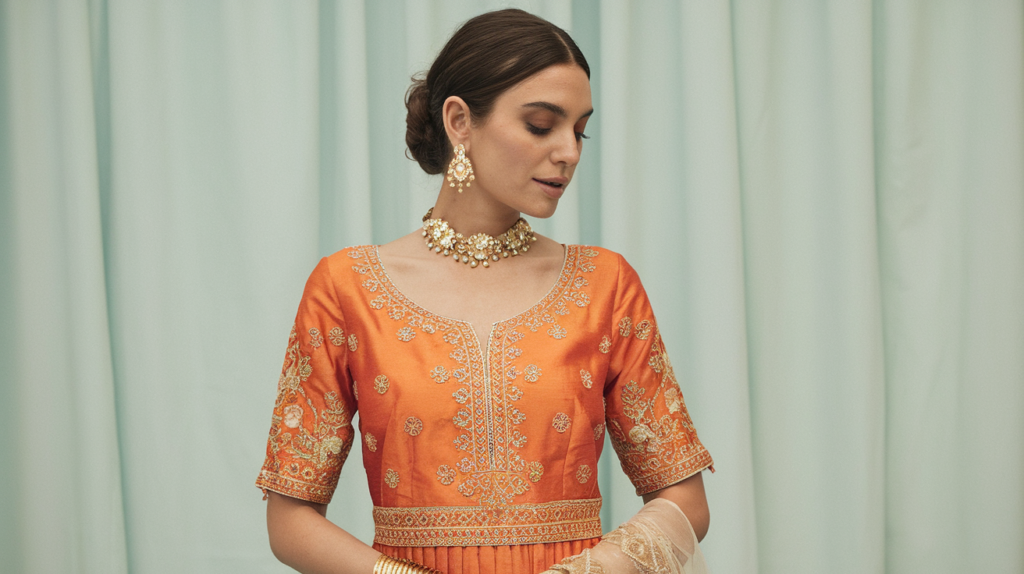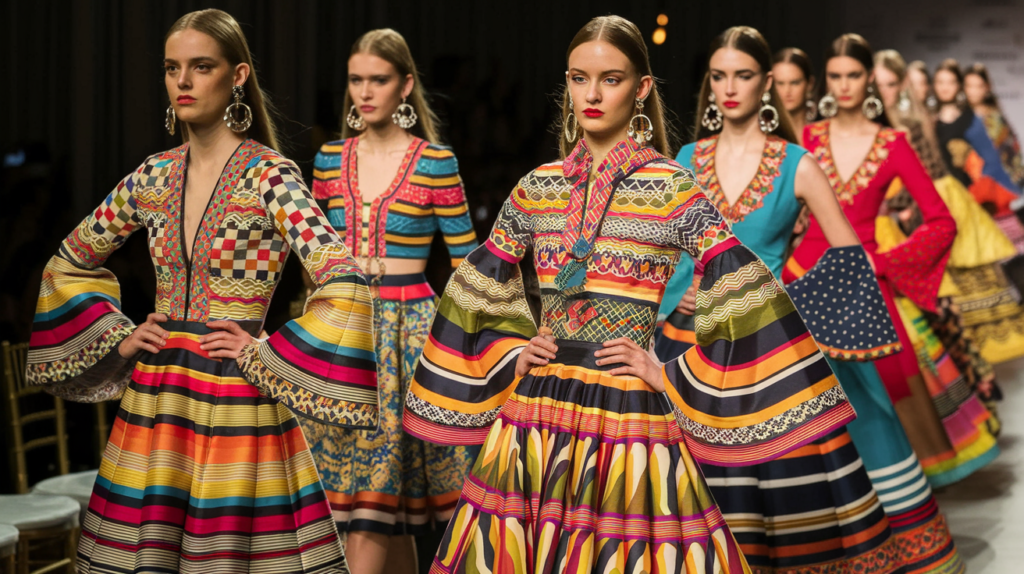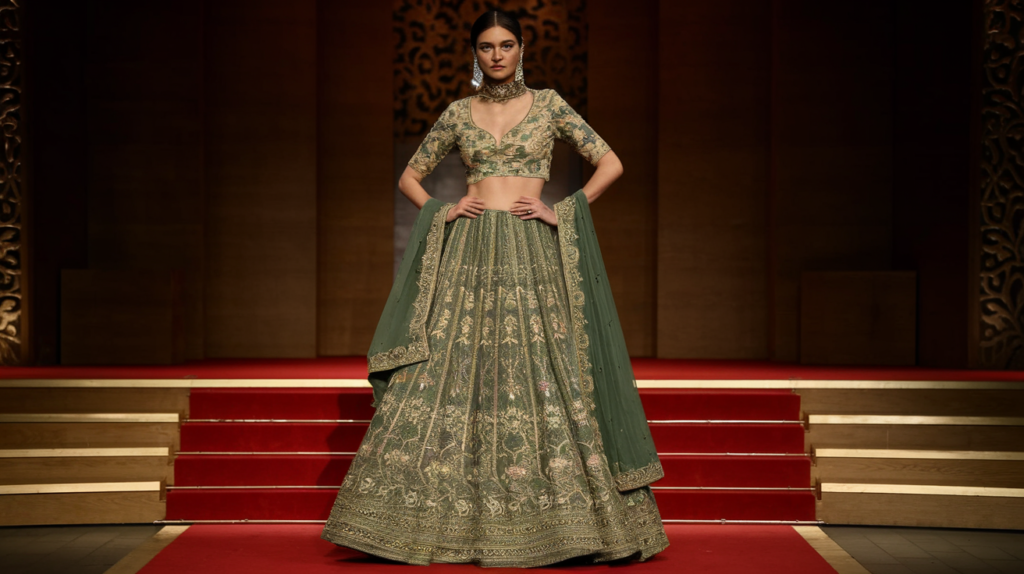The 1970s was one of the eras where fashion was experiencing change from boldness, eclecticism, and cultural changes. India in the 70s was full of life as it portrayed a mixture of traditional elements along with a lot of western influence. Indian fashion of the decade included so many silhouettes, prints, and fabrics that made it one of the most history-making moments in fashion. The article goes on to describe the unique retro style dresses of 70’s in India and why they remain an eternity in fashion.
1. A-Line Dresses: Simplicity with Glamour
One of the significant styles that emerged in the 1970s includes the A-line dress, perhaps one of the most classic styles ever to be adopted. The A-line is a flattering dress for almost all figures and was mostly worn for casual as well as formal events. India saw the main creation in cotton, khadi, and silk, which well represents the country’s immense textile traditions. The style of the A-line is simple yet classy and is also a contemporary reinterpretation of ancient tunics and kurtas.
Block prints and bright colours of Indian influence
Indian designers conceived bold and vibrant block prints, paisleys and florals in mustard yellow, deep maroon, and turquoise shades for the dresses. The marriage of Western silhouette with Indian prints made the A-line dress an overnight success among fashion-conscious ladies.
2. Bell Bottoms and Tunic Tops
Western Inspiration Meets Indian Comfort
Bell-bottom jeans came in the 70s and straight away, it was a staple piece of wardrobe. In India, it would be matched with a long tunic or kurti. Bell-bottom pants were so comfortable while being a fashion alternative to wearing a saree and salwar kameez.
How to Style Bell-Bottoms: A Fashion Revolution
Bell bottoms were made in denim or cotton fabrics that fit the hips then flared out from the knee. It was accompanied by long tunic tops with flared sleeves or intricate embroidery to be the epitome of effortless style. Indian women accepted this combination and it was often paired with a twist: mirror work, beadwork, or even dupattas were added to give it a unique fusion look.
3. Maxi Dress: Bohemian Dream
An Ode to Boho Chic
Maxi dresses embodied the free-flowing and gypsy characteristics of the bohemians of the 70s. Maxi dresses catered to an easy silhouette that could carry comfort while not being dropped in favor of style for women who wanted such styles. Prints were majorly ethnic here in India, so with Western dressing having Indian crafts, the product had something unique attached.
Popular fabrics: Georgette, Cotton, Silk
Maxi dresses are typically made from light weight fabrics such as georgette, cotton, and silk suitable for the climate of the country. The maxi dresses are mainly presented with minute embroidery or mirror work or bead work, which renders them suitable for daytime too, as well as parties in the night.
4. The Shift Dress: A Mod Fashion Inspiration
Simple Elegance with Clean Lines
One of the most stylish garments introduced in the 70’s was the shift dress that was widely embraced by new and young ladies in India. The cut of shift dresses is so modern in its simplicity in a long straight line fitting loosely upon the body; the style was so natural and versatile in terms of styling: block prints were used quite often with Paisley’s and embroidery over the clothing to give the garment local touch.
This shift dress would be great to pair with wide belts, sandals, or even juttis for a more traditional look, so it was versatile to wear formally or informally. Minimal in style, this could be experimented with the accessories like huge jewelry or embroidered shawls for a particular look.
5. Indo-Western Fusion-Traditional Meets Retro-Blending the Best of Both Worlds
India, in the 70s, saw the emergence of the Indo-western phenomenon of fashion, that harmonizes the traditional Indian clothes with the Western style. The style that was brought forth led to the marvelous retro-themed dresses that even the popular kurta dress could have only achieved if it had joined the comfort of traditional Indian wear to a straight-cut shift dress design.
Kurti Dress and Dhoti Pants

Kurti is actually a dress paired with the belt, set to the dhoti pants or leggings, that forms this classic 70’s outfit. The typical and nostalgic prints and designs were formed with stripes, geogroscopic shapes and designs as well as those having patterns of paisleys in that very eclectically expressive 70’s sartorial choice.
6. Prints: Geometrics, Florals, and Tie-Dye
Prints and Patterns Sit on the Throne
Indian in the 1970s experienced a print explosion. There were geometric prints, florals, tie-dye, and even a little bit of hand block printing. Dresses and frocks of the day came alive with saturated color and bold patterns. In some ways, whether the geometrically printed shift or tie-dye maxi dominated your day, the ’70s was the era that really made prints live and breathe.
Indian designers started using the regional prints, paisleys, block prints and motifs in the modern dresses. So, it was a blend of the Indian texture and the fashion forms of the West which provided an identity of style characterizing the decade.
7. Accessories: Headline Pieces of the 70s
Bulkier Jewelry to Headscarf
No 70s out is complete without the accessory right. Women in India are known for their flashy, chunky jewelry from big earrings to bangles to necklaces. With headscarves, especially long dresses or tunics complete the glamorous look on wearing them. This forms a retro look that takes the Indian tradition and includes in it the Western culture pop.
Shoes: From Juttis to Platforms
The 70’s also had the same amount of diversity in footwear. The Retros style dresses were paired with Indian juttis and traditional kolhapuris. Another high fashion of the decade in India was the platform shoe, which Indians used to give themselves height, as well as a pop of retro flavor to these otherwise very traditional outfits.
The Timeless Attraction of 70’s Retro Dresses in India
There were crucial transitions in Indian fashion that were observed, starting with the 1970s, a new generation of dresses presenting themselves in a retro style, and a perfect blend of global and local culture. Modern cuts with big prints minute detailing feature these dresses, and they are inspiration to designers today. Be it an A-line, the boho-inspired maxi dress, or the fusion looks, the 70’s retro style has definitely sealed its place in Indian history of fashion. With its perfect blend of tradition and modernity, it still remains to be an ever-relevant and celebrated part of the fashion world.
8. How Bollywood Shaped Fashion of 70’s Retro Dresses
Bollywood: The Fashion Stimulant
Fashion by the Bollywood influence started penetrating serious interest in India in the 1970s. They featured great actresses like Zeenat Aman, Hema Malini, and Rekha who became symbols in the country not just with their performing skills but by becoming icons of styles for women. The attires were bold, flowing fashion, full of zest about the 70’s fashion. The Bollywood diva inspired millions in India. From glamorous night outfits to bell-bottom trousers or flowy dresses the movie industry opted for which conquered the international arena.
Impact of Bollywood on Retro

Hare Rama Hare Krishna and Sholay are the epitomes of international fashion in its own way blended with traditional Indian fabrics, which can be called a Bollywood-70s fusion. Bollywood fashion-the brightness, eclecticism, and often rebellious character-succumbed to the attention of the young to make modernity combined with a rich Indian background mainstream and popular. Old dresses that the Bollywood heroines were seen in attained cult status and were imitated widely.
9. Revival of 70’s Retro Fashions in the Modern Ages
The Nostalgic Return
With the growing interest in the global world of fashions in vintage fashion, sustainable fashion, and retro fashion, 70’s retro fashion has started reviving themselves. The boom of bold prints, cuts, and colors of the 1970s seems to have been revolving inside the minds of designers nowadays. Indian fashion world does not seem to be exempt from this category, as well. Contemporary designers, with the infusion of the Western sensibilities into the Indian sensibility, are inspired by 70s. Retro style dresses such as A-line dresses, bell-bottom jeans, and maxi dresses modified to the current sensibilities would be made.
Sustainable and Vintage Fashion
Interest in the retro fashion is due to its popularity with the rise in sustainable fashion. Most of the dresses created in the 70s were made of natural fabrics. Most of the styles are ageless. Many of today’s people are seeking the vintage and retro styles in their dresses as an aspect of showing a greener wardrobe while embracing great fashion from the years of this fashion. It has been found that this period has been observed with trials on designers who use sustainable fabrics such as organic cotton, recycled silk, and earth-friendly dyes in dresses that draw inspiration from 70s.
10. Styling the 70’s Retro Dresses in Modern India
Perfect Fusion of the Past and Present
It is really all about merging the old with the new to bring 70s retro style into your wardrobe today. Mix vintage-inspired A-line dress with modern accessories, such as sleek leather boots or statement handbags, for instance. Or, mix boho-inspired maxi dresses with more modern styling elements such as a structured blazer or minimalist jewelry for a polished yet nostalgic look.
Footwear and Accessories for the Total Gown
The shoes complement the entire ensemble for the 70’s retro dresses. Platforms, wedges, and thick heels were already famous in the 70s and can be found today on the catwalk. To update this look, try to get brands that are environmentally friendly or some modern designs. Oversized sunglasses, fringe bags, and vintage scarves can all be added accessories to help give the look a retro feel. But don’t over-accessorize, and try to pick one or two signature pieces to balance and modernize your outfit.
11. Global Reach of Indian 70’s Retro Style
From India to the World: Indian Prints and Styles Go Global
The 70s was not just about Indian bold Western influences but also about Indian craftsmanship being appreciated in the international market. Women of every land wore the Indian fabrics- the khadi, bandhani, and block prints- intermingling it with the silhouettes of the West, maxi dresses, and bell-bottom pants which helped Indian fashion make its statement globally. International fashion icons and celebrities started carrying Indian textiles in their wardrobes, and that brought the country to a pretty prominent position on the world’s fashion scene.
The 70’s as a Cultural Bridge
For Indians, the 1970s were a period of cultural renaissance as they synthesized the bold, adventurous nature of the West into a rich cultural heritage to forge Indian-inspired fashion styles being exported to the West while the West influenced designers back in India to evolve in more experimental and modern design. The 70s created a cultural bridge which led to greater cross-cultural exchanges that continue defining the global fashion today.
12. Legacy of 70’s Retro Dresses in Indian Fashion Which Lasts Forever
The 70s mark a significant decade for Indian fashion, where global trends and traditional craftsmanship merged as one to create a uniquely and lasting style. For this reason, the clothing of this era, bold prints, flowy shapes, and fusions of ancient and modern elements, live on in fashion today. Worn with printed maxi dresses or chic A-line dresses and bell-bottomed pants, the 70s fusion style brings back that bygone era with its inimitable charm and charm. Retro dresses, revamped with a modern edge, are helping Indian fashion revive the spirit of the 70s. The styles of the 70s were not just about being fashionable; they symbolize self-expression, freedom, and the celebration of culture diversity, making them well-suited for the dynamism and diversity in current fashion.
13.70’s Retro Dresses for Special Occasions
Weddings and Celebrations: Vintage Glamour
Even though 70’s retro dresses are mostly dressed casually or bohemian, they also make a mark on festive and celebratory occasions. The brides in the 70s were seen wearing some of the most unusual wedding dresses seen ever; it could be maxi dresses with detailed embroidery and flowy skirts. Most of the Indian brides inspired by the era chose a Western silhouette with Indian textiles. Thus, a silk or chiffon gown with intricate zari work, embroidery, and mirrored accents was what they all opted for.
Festivals and Evening Parties: A Touch of Retro Style
A 70s retro dress is perfect attire for any special event be it Diwali, Eid, or any evening celebration. A fitted long-sleeved A-line dress or flowy maxi with rich fabrics and embellishments can quite easily become an elegant option. Statement jewelry such as chunky earrings, layered necklaces, and bold bangles, so highly popular from the 70s, perfectly complete the dresses, making them good for festivals while giving it a glamorous yet retro feel.
14. Indian 70’s Retro Dresses-The Influence of Global Fashion Trends
How Global Trends Inspired Indian Fashion
Indian fashion was pretty good with designers like David Abraham and Ravi J Shah in the 70s. They designed their own individual ethnic-inspired designs. And that’s it. It was from the hippie movement in the West to the boho chic in Europe that Indian fashion really opened its arms to the rest of the world, like when they used denim and velvet for traditional patterns. Bell-bottoms, floral prints, and peasant blouses from the West blended with Indian fabric techniques like block printing, bandhani, and mirror work. This fusion was behind an innovative, multi-dimensional style that defined the Indian fashion of the 70s.
Bollywood and Cultural Influence
Bollywood was just a mirror of Indian society but it reflects the latest trends of international fashion at the same time. The costumes of the stars on screen indicated a clear trend of international designers and Western trends. These are just some of the outfits with which hot pants and halter tops comprised the Westernised style found on Zeenat Aman’s body, all tied in together with Indian fabric. In the fashion, the coming together of these two, it would continue to echo powerfully with women’s hearts in India and this is thus continued into current times and becomes iconic styles for cross-cultural style that has developed in 70s retro dresses.
15. Eco Fashion: Reviving 70’s Retro Glamour
Sustainability in Retro Style
The 1970s also witnessed an era when sustainability entered the limelight of the fashion industry, though in a non-contemporary version of sustainability as it stands today in the form of eco-fashion. Indian apparel of the 70s is all about natural, organic textures like cotton, silk, and wool. The concept of sustainability repeats itself even today. The world is turning green in fashion. And it’s back in a sustainable movement in fashion: 70’s retro dresses characterized by light, breathable fabrics and minimalist designs. Today, many designers look for old traditional handwoven fabrics like khadi popularized in the 70s to create style with an environmental conscience.
Vintage Shopping and Upcycling Retro Dresses

In addition to this, sustainable advocacy, 70s retro dresses are a very coveted item in the vintage marketplace. Thrift stores and vintage boutiques and some online marketplace, even some second-hand are selling this dress made of sustainable materials, and sometimes just simple, long-lasting timeless pieces. This is because some of the pieces were done in quality materials and the craftmenship which could last much longer. Among these trends upcycling and restyling vintage 70s dresses, that is when designers and enthusiasts of the fashion world renew these icons by changing the fit or adding new decoration, which in turn generates unique outfits, one-time pieces continuing the legacy of 70s fashion.
16. Iconic Fabrics and Textures of 70’s Retro Dresses
Velvet, Suede, and Chiffon: Textures of the 70s
The 70s broke new textures and material into the world of fashion. Velvet was a pricey luxury material that was used only for evening wear. Suede made its mark with earthy, boho vibes, and both went hand-in-hand with traditional Indian dresses – that’s to say, with silk and cotton use – although retro-style dresses were extremely popular in India. Maxi dresses and tunics were used in chiffon, giving a very flowy yet ethereal appearance to them.
Geometrics and florals: the play of prints and patterns
Bold print and pattern usage were one of the main characteristics of 70s retro dresses. Geometric prints, like squares, diamonds, and circles, were most common on tunics, shift dresses, and A-line skirts. The iconic style of this era was achieved through floral prints, big bold blooms, or tiny delicate patterns. In India, the prints were typically done through the traditional technique of block printing, adding to the overall feel of modernity coupled with heritage.
17. How to Style a 70’s Retro Indian Dress
Try pairing it with various silhouettes and colors
The key to pulling off that 70s-inspired dress today is embracing the bold color palettes and unique silhouettes of the time. Try a bright mustard yellow A-line dress or a deep turquoise maxi for a striking statement. For a more contemporary feel, opt for a retro style with a modern silhouette, such as a flared dress with minimal accessories or a floral print with a structured jacket.
Indian Fabrics and Techniques: Use a bit of Indian craftsmanship with your 70s retro look. A shift dress in handloom cotton or a velvet maxi dress that boasts mirror-work accents are both modern yet ageless. Colorful bangles, chunky earrings, and juttis complete the retro dress for the touch of India’s old rich textile heritage.
Also read : Payday Loans and Eloanwarehouse: What You Need to Know
Conclusion: An Infatuation with Timeless Fashion
This retro dress from the 70s in India symbolizes more than a fashion trend, but a symbol of cultural exchange, self-expression, and creativity. Its bold patterns, rich textures, and innovative fusion of Western and Indian influences continue to inspire designers and fashion lovers to date. From embracing the bohemian maxi dress, to the fashionable A-line, and casual bell-bottoms, all these styles have stood the test of time, which in a nutshell, speaks to the free-spirited energy of the 70s and the timeless essence of Indian traditions.
These retro dresses in modern-day India have endless possibilities for experimenting and styling with the best of the past combined with the present, thus producing a fashion as relevant to today as it was way back in the 1970s. Whether it is for a casual outing, festival, or a formal event, the timelessness of the 70s retro dress is here to stay and influence Indian and global fashion for generations to come.

